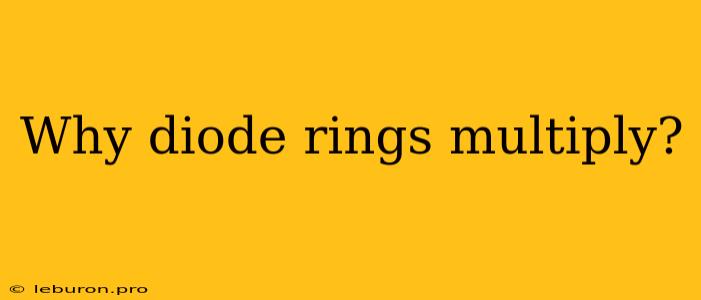Diode rings, also known as voltage multiplier circuits, are essential components in many electronic devices. They are particularly valuable for converting low-voltage direct current (DC) sources into higher voltage DC outputs. This process is achieved through the clever arrangement of diodes and capacitors in a specific configuration. But how do these seemingly simple circuits achieve this remarkable voltage multiplication? This article delves into the intricate workings of diode rings, exploring the principles behind their ability to boost voltage levels.
The Fundamental Principle: Rectification and Charge Storage
The foundation of diode ring operation lies in the combined actions of rectification and charge storage. Diodes, acting as one-way gates for electrical current, play a crucial role in rectifying alternating current (AC) into pulsating DC. Capacitors, meanwhile, serve as temporary reservoirs for storing electrical charge.
Imagine a simple circuit with a single diode connected to an AC source. During the positive half-cycle of the AC input, the diode conducts, allowing current to flow through it and charge the capacitor connected in parallel. During the negative half-cycle, the diode blocks current flow, preventing the capacitor from discharging. The result is a pulsating DC voltage across the capacitor, with a peak value determined by the amplitude of the AC input.
Diode Ring Configurations: A Deeper Dive
While the basic principle is simple, diode rings utilize a clever arrangement of diodes and capacitors to achieve significant voltage multiplication. The most common configurations include:
The Voltage Doubler
The voltage doubler, as the name suggests, effectively doubles the peak voltage of the AC input. It comprises two diodes and two capacitors. During the positive half-cycle of the AC input, one diode conducts, charging the first capacitor. During the negative half-cycle, the second diode conducts, charging the second capacitor. The output voltage is then taken across both capacitors, resulting in a voltage twice the peak voltage of the AC input.
The Voltage Tripler and Quadrupler
The principle extends to higher multiplication factors. A voltage tripler uses three diodes and three capacitors, while a voltage quadrupler utilizes four diodes and four capacitors. In each case, the diodes and capacitors work in concert to accumulate charge during each half-cycle of the AC input, ultimately resulting in an output voltage that is a multiple of the peak input voltage.
Understanding the Role of Diodes and Capacitors in Voltage Multiplication
Diodes act as switches, selectively allowing current flow in one direction only. They are crucial for rectifying the AC input, enabling the capacitors to charge during specific half-cycles.
Capacitors serve as charge storage elements. They accumulate charge during the conductive half-cycles and retain it during the non-conductive half-cycles. This stored charge contributes to the overall output voltage.
Factors Influencing Diode Ring Performance
Several factors influence the performance of diode ring circuits, including:
- Input Voltage: The peak voltage of the AC input determines the maximum output voltage achievable.
- Capacitor Values: Larger capacitor values provide greater charge storage capacity, leading to smoother output voltage and higher ripple reduction.
- Diode Characteristics: The forward voltage drop across the diodes affects the overall output voltage.
- Load Current: The current drawn by the load affects the ripple voltage and overall efficiency.
Applications of Diode Rings
The ability to increase voltage levels makes diode rings valuable in a wide range of applications, including:
- Power Supplies: Diode rings are used in power supplies to convert low-voltage AC or DC into higher voltage DC outputs.
- High-Voltage Generators: They are employed in high-voltage generators for applications such as photocopiers, laser printers, and electrostatic precipitators.
- Voltage Boosters: Diode rings can boost voltage levels in electronic circuits requiring higher voltages, such as amplifier stages and certain types of sensors.
Advantages and Limitations of Diode Ring Circuits
Advantages:
- Simplicity: Diode ring circuits are relatively simple to construct, requiring only diodes and capacitors.
- Cost-Effective: They are generally inexpensive to manufacture.
- High Efficiency: With proper design, diode rings can achieve high efficiency in voltage conversion.
Limitations:
- Ripple Voltage: The output voltage of diode ring circuits is not perfectly smooth and contains a ripple component. This ripple can be minimized by using larger capacitors and careful circuit design.
- Voltage Limitations: The maximum output voltage achievable is limited by the peak input voltage and the number of stages in the diode ring.
- Load Current: Diode ring circuits are typically designed for low to moderate load currents.
Conclusion: Unleashing the Potential of Voltage Multiplication
In conclusion, diode rings are powerful and versatile circuits that provide a practical means of multiplying voltage levels. Their ability to convert low-voltage DC sources into higher voltage outputs makes them essential components in numerous electronic applications. The fundamental principle of rectification and charge storage, along with the clever arrangement of diodes and capacitors, lies at the heart of their remarkable voltage-boosting capabilities. Understanding the factors influencing diode ring performance and their advantages and limitations enables engineers to design and implement efficient and reliable voltage multiplication circuits for a wide range of electronic systems.
